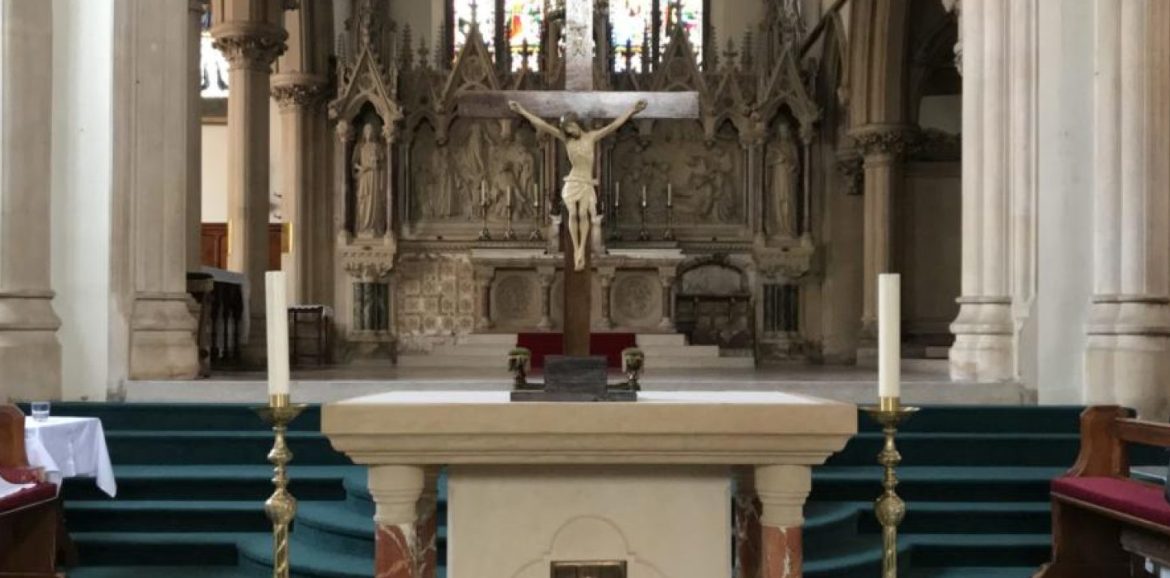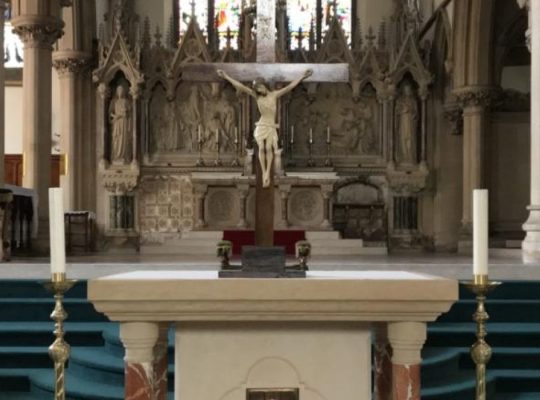Every Sunday of Lent commemorates one of the main events of salvation history. The giving of the Decalogue on Sinai is, among all others, a notable fact in this history. The Decalogue —also called the Ten Commandments—is the fundamental law that regulates the moral life of the people. Jesus recalled several of its precepts. Saint Augustine made them the framework for his teaching on Christian morality. The condensed and easily memorized formulation of God’s commandments has been, in successive ages and even up to the present day, the basis of catechesis and of exposition of Christian conduct toward God and others. The Decalogue is, therefore, a venerable biblical text.
He [God], tells us that he is a jealous God. This qualifier might at first surprise us, but it must be remembered that the Bible readily resorts to the image of marriage to describe the covenant between God and his people. God is jealous because his love cannot bear the unfaithfulness or the indifference of his own. ‘You shall not take the name of the Lord in vain.’ The holiness of God is involved here; it is a blasphemy to take the Lord’s name with the intention of associating it with an evil action. This is far reaching. How can we invoke, or name, God in prayer and afterwards harm others? ‘You shall not kill. You shall not commit adultery. You shall not steal. You shall not bear false witness against your neighbour. You shall not covet your neighbor’s house, or wife, or servant, his ox, his ass, or anything he has.’ ‘And you must honour your father and mother.’ ‘You shall have no gods except me.’ ‘And you shall remember to keep holy the Sabbath.’ Keeping the Sabbath holy and refraining from labours is presented as a weekly release from the servitude of daily work by which all must benefit, male and female servants, immigrants, and even animals. This rest of the seventh day is an act of worship rendered to God, who has given freedom to his people. ‘You shall not oppress aliens (strangers) , since you were once aliens yourselves in the land of Egypt.’ (Exod 23:9). It is truly a law of liberty that God has promulgated, whose application would change many things in the world. God’s commands are ‘tools for good works,’ revelations of the Lord, ‘Words of eternal life.’
All through sacred history, God shows himself to be a loving God, yet he also shows himself to be sometimes, disconcerting in his initiatives, as well as in his choice of bringing about his plans. His way of acting is so contrary sometimes to human wisdom and calculation that the temptation not to follow him on this path is sometimes great, and we are in desperate need of the grace of perseverance. We do not think as God thinks but as man thinks. The four Gospels report that one day Jesus chased the merchants and money changers from the Temple. An act that in hindsight was quite proper, yet, to those cast out from the Temple, a catastrophe, for they had been there for years, going about their business.
John’s Gospel sees in Jesus’ action, a sign to be understood by faith, and it attests to the reflection of the early Church on this event. Therefore, it is important especially during Lent, to read this Gospel passage from the viewpoint and in the spirit of John when he wrote it down. The reading of this text requires great attention because it uses an ensemble of biblical data and themes: the Temple, its significance and its future; the Messiah; the salvation of Israel and the nations; and the end times. But, through all this, the focus is on the person of Jesus and his mystery. The evangelist wanted us to remember this episode so that we might believe that Jesus is the Christ, the Son of God, and that by believing in him we might ‘have life in his name.’
In the Bible, the Temple is the sign of God’s presence amid his people, as well as, of salvation in progress. It is from the Temple that the light and glory of the Lord shine forth, that the water giving life to all creation springs up. Destruction and reconstruction of the Temple are always connected with the dispersion and reunification of God’s people, with the salvation of the nations that ascend to Sion in pilgrimage.
Notwithstanding all of the above, the people were waiting for a new temple, expected to come down from heaven on the day when God would definitively reside among his people. This would happen with the coming of the Messiah, who would cleanse the Temple. The veneration of the edifice of stone, centre of worship, special place of the only true God, and symbol of his glory, thus opened onto wide spiritual horizons under the impulse of the prophets’ preaching, particularly during the Exile. On foreign soil, the people had experienced God’s presence, unconnected with a sacred enclosure: ‘Though I have removed them far among the nations and scattered them over foreign countries—and was for a while their only sanctuary in the countries to where they had gone……’ (Exod 11:16) This experience of exile and prophetic preaching fostered the rise of a temple spirituality that has continued to develop to this day.
‘Thus says the Lord…..What kind of house can you build for me; what is to be my resting place? My hand made all these things when all of them came to be…..’
These words are not meant to authorize any contempt for the buildings in which the assembly gathers for the proclamation of the Word, prayer and praise of the Lord. But a word of caution is in order against formalism, against a conception and practice that would ignore the fact that temples are signs. Finally, what is important is spiritual worship, worship ‘In Spirit and truth.’ The action of Jesus must be placed in this context. In some way, he acts out a parable. The disciples will understand this and understand it today by remembering the prophet’s prediction, ‘On that day there shall no, longer be any merchant in the house of the Lord of hosts.’ (Zech 14:21) ‘Zeal for your house consumes me.’ (Ps 69:10) But the Gospel does not stop here. It reports a mysterious word of Jesus that will make sense only later.
In driving out merchants and money changers, Jesus acts a s a prophet assured of his authority. Those who are the first witnesses of the vehement manifestation of zeal for God’s house understand its significance. We can sympathize with their reaction, ‘What sign can you show us for doing this?’ But it does not matter. What interests us is Jesus’ answer, ‘Destroy this temple and in three days I will raise it up.’ We must admit that this word in itself is quite enigmatic. If he is talking about ‘This Temple’ from which he has just expelled merchants and money changers, Jesus only opens himself up to mockery, ‘This temple has been under construction for forty-six years, and you will raise it up in three days?’ In effect, this is absurd. What does he mean? What is this irrefutable sign of his authority? John hastens to explain. ‘But he was speaking of the temple of his body.’ And immediately he adds that the disciples remembered these words of Jesus and deciphered their meaning ‘when he was raised from the dead.’ In fact, the verb ‘to get up again’—‘egeirein’ in Greek—is used to mean ‘to bring to life again’ in the technical Christian vocabulary. But the significance of this word of Jesus is due not only to the use of a Greek word with two possible meanings. John says that the disciples, remembering after the resurrection what Jesus had said, ‘came to believe in the scriptures and the word Jesus had spoken.’
Today’s Christians are even better off. They have at their disposal the writings of the New Testament and, in particular, John’s Gospel. At the beginning the evangelist wrote: ‘And the Word became flesh and made his dwelling among us, and we saw his glory, the glory as of the Father’s only Son, full of grace and truth.’
Jesus worked signs and manifested this glory: thus, the raising of Lazarus etc. Finally, there is this quite explicit text in Revelation: ‘I saw no temple in the city [the heavenly Jerusalem], for its temple is the Lord God almighty and the Lamb.’ The major sign, that which justifies what Jesus did and gives authority to his words, the sign that reveals him as Son of God, is his resurrection. But all signs, and in particular this one, demand a total commitment that the Lord can trust.
‘While he was in Jerusalem for the Feast of the Passover, many began to believe in his name when they saw the signs he was doing. But Jesus would not trust himself to them because he knew them all and did not need anyone to testify about human nature. He himself understood it well.’ Several times, John inserts in his Gospel a similar summary. ‘Jesus did this at the beginning of his signs in Cana in Galilee and so revealed his glory, and his disciples began to believe in him.’ What is treated here (and other places) is the subject of signs and the faith they produce, in some people, while in others they provoke hostility. Therefore, it is fair to say that signs are intended to produce faith, but they do not force It. In some, faith is short lived, but we must go to the end, to faith in Jesus himself, who is, by his death and resurrection, the ultimate sign toward which all other signs are directed. As for Jesus, he has no need of signs to know what is in the human heart. He has direct knowledge of it, like God, ‘Who fashioned the heart of each, / he knows all their works.’
The commandments that God decrees at Sinai, in our First Reading, are the charter of a people freed from slavery. It is a covenant contract assured of unfailing faithfulness that the Lord proposes to his people, entreating them to become wholeheartedly attached to him. Even when they turn away from him, God in his mercy, does not abandon the humans whom he loves, going so far as to send his own Son to save the world, the Son who delivered himself to death. A crucified Messiah! This is the scandal and folly in human eyes. And yet it is the supreme wisdom and strength of a God who is love. In his Son, dead and risen, he makes of believers, by the Holy Spirit, the temple where he resides.
To believe is to recognise in Jesus the Wisdom of the living God and to walk in his footsteps, remembering both his words and the signs he worked.
‘I am the resurrection and the life, says the Lord, whoever believes in me will never die.’


